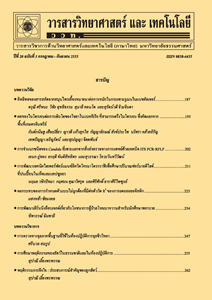การเปรียบเทียบวิธีการประมาณค่าแบบช่วงสำหรับสัมประสิทธิ์การถดถอยของตัวแบบโลจิสติกเมื่อใช้การประมาณค่าพารามิเตอร์ด้วยวิธีภาวะน่าจะเป็นสูงสุดและวิธีฟังก์ชันจำแนกประเภท
Main Article Content
Abstract
บทคัดย่อ
งานวิจัยนี้มีวัตถุประสงค์เพื่อเปรียบเทียบประสิทธิภาพของวิธีการประมาณค่าแบบช่วงสำหรับสัมประสิทธิ์การถดถอยของตัวแบบโลจิสติก 3 วิธี คือ วิธีคลาสสิค วิธีปริมาณหมุน และวิธีแบบเบส์ เมื่อใช้วิธีการประมาณค่าพารามิเตอร์ด้วยวิธีภาวะน่าจะเป็นสูงสุด และวิธีฟังก์ชันจำแนกประเภท เกณฑ์ในการเปรียบเทียบ คือ ค่าสัมประสิทธิ์ความเชื่อมั่นและความกว้างเฉลี่ยของช่วงความเชื่อมั่น กำหนดจำนวนตัวแปรอิสระเท่ากับ 3, 5 และ 7 ตัวแปร โดยตัวแปรอิสระมีการแจกแจงแบบปกติมาตรฐาน ส่วนตัวแปรตามมีการแจกแจงแบบเบอร์นูลี ค่าพารามิเตอร์เริ่มต้น เท่ากับ 1 ขนาดตัวอย่าง เท่ากับ 20, 30, 50 และ 100 กำหนดระดับสัมประสิทธิ์ความเชื่อมั่นเท่ากับ 0.90, 0.95 และ 0.99 จำลองข้อมูลภายใต้สถานการณ์ต่าง ๆ ด้วยเทคนิคมอนติคาร์โล ทำซ้ำในแต่ละสถานการณ์จำนวน 2,000 รอบ ผลการศึกษาพบว่าการประมาณค่าทั้ง 3 วิธี ให้ค่าสัมประสิทธิ์ความเชื่อมั่นไม่ต่ำกว่าค่าสัมประสิทธิ์ความเชื่อมั่นที่กำหนดในทุกสถานการณ์ และการประมาณค่าแบบช่วงด้วยวิธีปริมาณหมุนให้ค่าความกว้างเฉลี่ยของช่วงความเชื่อมั่นแคบที่สุด ส่วนวิธีคลาสสิคและวิธีแบบเบส์ให้ค่าความกว้างเฉลี่ยของช่วงความเชื่อมั่นใกล้เคียงกันในทุกสถานการณ์ แต่เมื่อขนาดตัวอย่างเพิ่มขึ้นการประมาณค่าทั้ง 3 วิธี ที่ได้จากการประมาณค่าพารามิเตอร์ด้วยวิธีฟังก์ชันจำแนกประเภทจะให้ค่าความกว้างเฉลี่ยของช่วงความเชื่อมั่นแคบกว่าวิธีภาวะน่าจะเป็นสูงสุดในทุกสถานการณ์
คำสำคัญ : การถดถอยโลจิสติก; การประมาณแบบช่วง; สัมประสิทธิ์การถดถอย; วิธีภาวะน่าจะเป็นสูงสุด; วิธีฟังก์ชันจำแนกประเภท
Abstract
The objective of this research is to compare three intervals estimation methods for the coefficient of logistic regression. The estimation methods are classical method, pivotal quantity method and Bayesian method which the coefficients are estimated by the maximum likelihood method and the discriminant function method. The comparison criterion is based on the confidence coefficient and the average widths of the confidence intervals. The study is performed using: the independent variables equal to 3, 5 and 7 which are standard normal distribution, the dependent variable is Bernoulli distribution, the initial value and the sample sizes are 20, 30, 50 and 100. The confidence coefficients are 0.90, 0.95 and 0.99. Monte Carlo simulations are conducted with 2,000 replications for each case. The results show that all three methods have the coverage probability not lower than the nominal level for all situations. Pivotal quantity method has the smallest average widths. In terms of average widths, classical method is as good as Bayesian method for all situations. Moreover, all three methods which the coefficient are estimated by the discriminant function method have smaller average widths than the maximum likelihood method for all situations.
Keywords: logistic regression; interval estimation; regression coefficient; maximum likelihood method; discriminant function method


